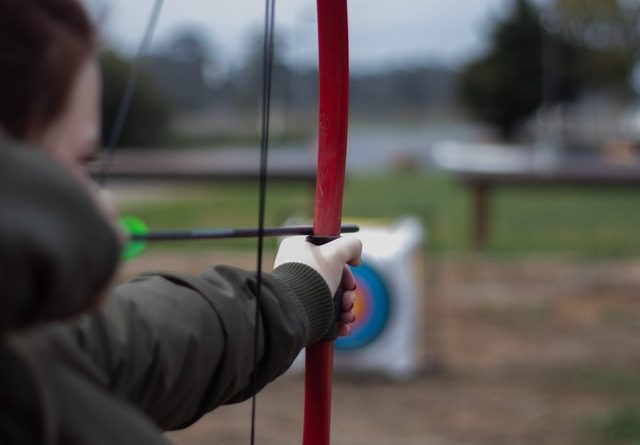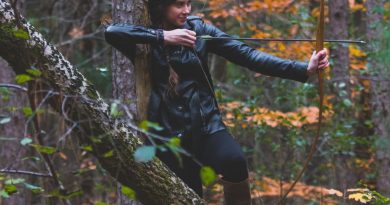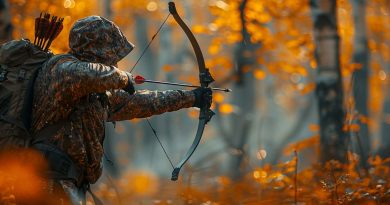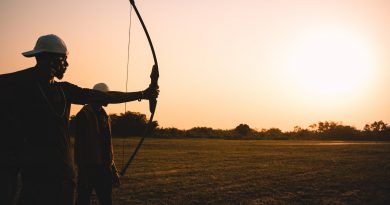Rounds
In these days of limited hunting seasons and restricted bag limits, it is impracticable for an archer to acquire proficiency in the use of the bow in the actual hunt. A shot gun pattern allows for a reasonable margin of error when pointing at game; so that we habitually lay the gun away at the end of the hunting season and may not shoot it again until another season rolls around. Even so, we account for a reasonable and satisfactory share of the game which we flush. The archer is in an entirely different category—he has no margin of error when he hunts with the bow. The arrow must fly true to the mark, and there is no short cut to accuracy. Practice is essential, and the number of hits recorded in the hunting field is directly proportional to the hours of practice on the field course and the target range. The maxim, “It is the man behind the bow who scores the hits,” is one that every archer should remember. Too many novices attempt to buy accuracy by the purchase of high priced equipment. There is also the prevailing but erroneous impression among beginners that a heavy hunting bow—45 to 60 pounds drawing weight, or more—will make up for lack of marksmanship. It is unfortunate that some of us, in fact, too many of us have to learn the hard way—strained muscles and sore fingers are the inevitable result of attempting to learn to shoot with a heavy bow.
If during the past hunting season you got within bow range of a nice buck, and then were unable to score a hit, it is time to sit down and take stock of the situation. It does not matter what series of circumstances lead to that miss. One thing should be evident. An archer has to be a marksman, if he is to measure his success in the hunting field by the kill. Enough records have been compiled to warrant the assertion that the average distance at which deer are shot with the bow is slightly under thirty yards. It is not too difficult to attain accuracy at short distances, and this should be the aim of the bowman.
To learn to shoot well, the novice need only acquire a moderate priced bow, drawing not more than thirty (30) pounds, preferably twenty-five (25) pounds. But he must find time to practice, if only at infrequent intervals. The next step is to join a group of fellow archers and spend an occasional pleasant afternoon on a practice range. Self analysis of one’s shooting form is a difficult task. A friend, however, can easily pick out flaws in your shooting technique and call them to your attention so that you may correct them and improve your percentage of hits. With your light weight bow you can concentrate on developing proper shooting form. The bow can be held steady at full draw, and you can shoot throughout the afternoon without undue fatigue or danger of strained muscles. A lot can be learned by watching an experienced archer handle his bow. He knows the essentials that must be mastered and will willingly share that knowledge with you.
Men who have never shot in a tournament are reported to have killed deer, and during a recent season an archer was reported to have killed a deer after only three and a half hours practice with a bow. Such instances are the exception and not the rule. Certainly one can practice alone, but a great deal of pleasure is had from shooting in the company of fellow archers, and in competing in the numerous rounds which are designed to improve the archer’s ability as a marksman to the end that he register a clean kill when he goes into the hunting field.
To stimulate group shooting, to provide a means by which archers may compete on terms of equality with each other, to enable each archer to record improvement in his marksmanship, and most important, to make practice a pleasant occasion rather than an arduous duty, certain standard rounds have been adopted in both target and field shooting.
Target archery, which consists of shooting at a stationary target at known distances, provides the hunter with an opportunity to accustom himself to his weapon, to become proficient in its use, and to loose an arrow to the mark. The field archer, shooting on the practice butts of a field course is really engaging in a modified form of target archery. Lacking is the incentative that comes from competition which is provided by the standard rounds shot on the target range.
Target Hounds N.A.A.
American Round: 90 arrows—30 each at 60, 50, and 40 yards. Scores are recorded after each end of six arrows has been shot. A “possible” for the American Round is a score of 90—810. The first
York Round: 144 arrows—72 at 100 yards, 48 at 80 yards, and 24 at 60 yards. “Possible” for the York Round is 144—1296. The all-time record in national competition in the United States is held by Joe Feies, who scored 140-974 in the 1955 tournament.
The combined scores of a double American and a double York round are the basis on which the target champion is determined at the annual tournament conducted by the National Archery Association of the United States.
Other events which may be used in target tournaments are:
National Round: 48 arrows at 60 yards, and 24 arrows at 50 yards.
Columbia Round: 24 arrows at 50 yards, 24 at 40 yards, and 24 at 30 yards.
Junior American Round: 30 arrows at 50 yards, 30 at 40 yards, and 30 at 30 yards.
Junior Columbia Round: 24 arrows at 40 yards. 24 at 30 yards, and 24 at 20 yards.
Hereford Round: 72 arrows at 80 yards, 48 arrows at 60 yards, and 24 arrows at 50 yards.
Field Rounds N.F.A.A.
Excellent preparation for the hunt is the sport of field archery, which is governed by the rules of the National Field Archery Association. Competition is organized under conditions intended to simulate those which would be encountered in the hunting field, and the archer is required to shoot without knowing the distance the target is placed from the shooting post.
Field Round Roving: consists of 28 field targets, which may consist of two units of 14 targets, each containing all the official shots or twice around a course containing a single unit of 14 targets. The required shots are described in the chapter on Construction of a Field Roving Course; the method of scoring is described in the Chapter entitled: Scoring and Classification of Archers. The all-time record in the annual tournament of the National Field Archery Association for the Field Round in the Free Style Division is held by Reuben Powell with a score of 930. In the Instinctive Division the all-time record holder is Harold C. Doan with a score of 845.
Broadhead Round: The last step in the field archer’s preparation for an actual hunt is participation in a broadhead round as discussed in a previous chapter. In most field events, it is common practice to use field or target arrows. The broadhead round, however, is the post graduate course for the bowman who aspires to hunt with the bow. In this round, the archer shoots a modification of the standard field course distances using the actual broadhead. Having advanced by progressive stages to the broadhead round, the bowman can quickly adapt his shooting technique to deliver a broadhead to the mark with the same consistency with which he scores with his target or field arrows.
The targets for this round are life size animal targets with the scoring area divided into two parts. The inner one is a circle which varies in size up to a maximum of 12 inches and is invisible from the shooting position. It is centered on the heart area. The other scoring area includes all the animal except ears, horns, tail, etc. Targets vary in size and should be arranged according to the length of the shot, with the largest targets placed at the longest ranges.
The round consists of 28 targets set at distances varying from 10 to 60 yards, but with an average distance of 30 yards over the entire course for a total of 840 yards. A number of variations are permitted in laying out this type of course with the shorter ranges and the greater variation in distances permitted for each shot than is permitted in setting up the Field Round.
The bow is a low velocity weapon, and lead is of paramount importance in shooting at running game. At static targets, the field archer does not gain experience at this type of shooting. You will have to learn to come to full draw behind the game, swing through it and out in front, and release the arrow, while the bow is traveling in the direction the game is moving. Fortunately, since the arrow can be seen in flight by the field archer, he can quickly demonstrate to his own satisfaction how necessary it is to lead running game. A moving target, approximately 24 inches wide by 18 inches high, padded with upholsterer’s cotton, and covered with canvas; running on a wire strung tightly between two trees or posts will serve as an excellent substitute for running game. The bowman can use broadheads in practice, as the upholsterer’s cotton acts as a shock absorber, and the point of the arrow will not penetrate the wooden backing to such an extent that it would be difficult to withdraw.
Hunter’s Round: The average target distance for this round is 35 yards, and the total yardage for the 28 targets must be 980 yards, plus or minus 5%. The shooting positions for the Hunter’s Round fall between the positions staked for the Field and Broadhead Rounds. Stake out the Hunter’s Round with red topped stakes. The stakes are driven at random distances anywhere between the white and blue stakes which represent the shooting positions for the Field and Broadhead Round respectively. On short four position shots a red stake may appear farther back than a white stake. Staked in this manner the distances will be unkown and scores shot on different courses may not be comparable. All of the long shots between say 55 and 70 yards should be two position and may be identified by a single red stake. Two arrows are shot from each side of the stake.The medium distance shots from approximately 30 to 50 yards require two stakes for a four position shot. The archer shoots one arrow from each side of each of the two stakes. The two stakes should be set at different distances from the target and the shots may be varied between walk-ups and walk-backs.
On targets at distances under 30 yards, use four stakes and shoot one arrow from each stake. Within the limits prescribed the stakes should be driven at random to present a variety of shooting positions and yardages. The method of scoring is the same as that used in the Field Round.
Targets for the Hunter’s Round have an all-black background. The targets have a pencil lined bullseye one-half of the diameter of the scoring area with a white aiming spot in the exact center. The cardboard should have a diameter one inch greater than the scoring area in order to provide a skirt one-half inch in width on which close misses can be clearly identified. Target colors may be varied as long as the aiming spot is a contrasting color. The accompanying table lists the target dimensions for the different yardages.
TARGET DIMENSIONS
Diameter Aiming
Yardage Face Scoring Area Spot*
45 and up 25″ 24″ 4″
35 and 40 19″ 18″ 3″
15, 20, 25 & 30 13″ 12″ 2″
Bird Shots 10″ or 12″ 6″ 1″
* Since the spot has no relation to the scoring, its size may be varied.




